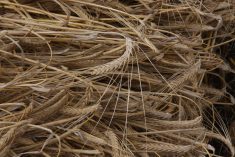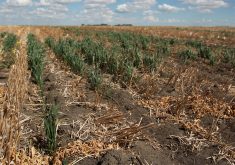Producers need to frequently monitor stored kabuli chickpea seed to preserve its value.
“Pulse crops such as chickpea have large seeds that may require time for the interior moisture to equalize throughout the seed,” said Ray McVicar, a special crops specialist with Saskatchewan Agriculture.
“This is known as ‘going through a sweat.’ There is the possibility that the seeds will sweat in the bin. Because there could be considerable change in the results of a moisture test over time, the stored grain should be tested several times during the first few weeks.”
To test the seeds, break some of them open. The interior should snap if the seeds are dry. A soft and chewy seed interior may lead to spoilage.
A moisture meter helps, but one test will not provide the proper information for safe storage if moisture has not yet equalized throughout the seed. Moisture levels should be 14 percent for safe storage.
“The key to avoiding mould and other storage problems is the use of aeration to cool and dry the seed.”
















